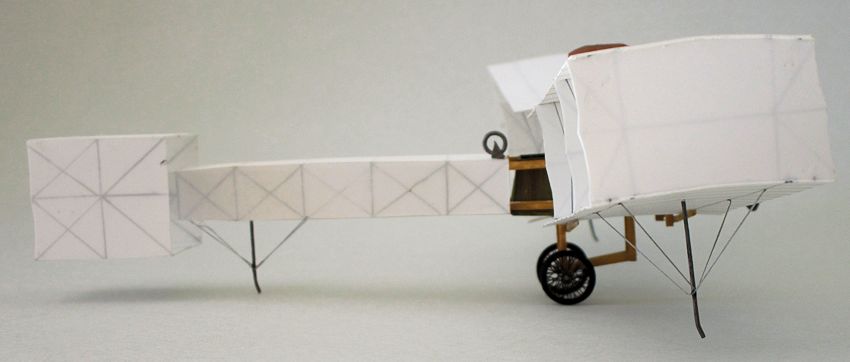
| KIT #: | |
| PRICE: | $ |
| DECALS: | None |
| REVIEWER: | Chris Peachment |
| NOTES: | Notes: Made from 10 and 20 thou plastic card, rod and sprue |

| HISTORY |
I have written before on the Brazilian pioneer Alberto Santos-Dumont, in my build of his Demoiselle, but for those who don't want to refer back to that, here is a little about him again.
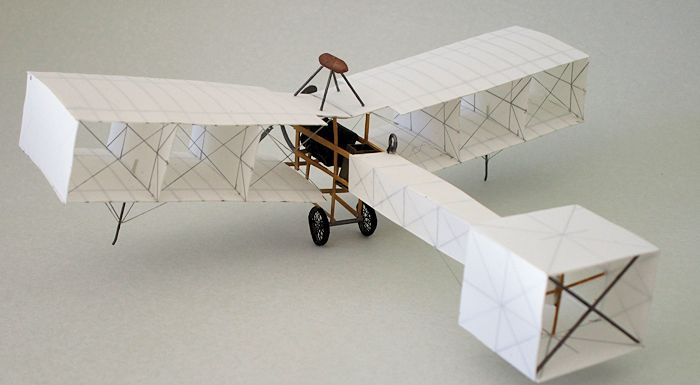 He is the father
of European aviation. One of the most famous men in his day, he is still a much
lauded hero in his native Brazil. Born in 1873, into a large, very wealthy
family of coffee producers. His father used the most modern technical equipment
on his coffee plantation and Alberto was using the steam tractors and other
vehicles from an early age. When his father became a paraplegic, he sold the
plantation for a vast sum, and Alberto settled in Paris, where he began
experimenting with balloons. He designed and built the first dirigibles, which
was the first time a balloon could be steered, and he won a prize for flying a
circuit which involved circling the Eiffel Tower.
He is the father
of European aviation. One of the most famous men in his day, he is still a much
lauded hero in his native Brazil. Born in 1873, into a large, very wealthy
family of coffee producers. His father used the most modern technical equipment
on his coffee plantation and Alberto was using the steam tractors and other
vehicles from an early age. When his father became a paraplegic, he sold the
plantation for a vast sum, and Alberto settled in Paris, where he began
experimenting with balloons. He designed and built the first dirigibles, which
was the first time a balloon could be steered, and he won a prize for flying a
circuit which involved circling the Eiffel Tower.
He would often steer these small craft down the length of fashionable boulevards about 20 feet above the traffic and crowds, and then tether the craft to a nearby tree while he took lunch at his favoured restaurant. He would also visit friends by air, tying the craft to whatever was to hand, sometimes on the roof of the house.
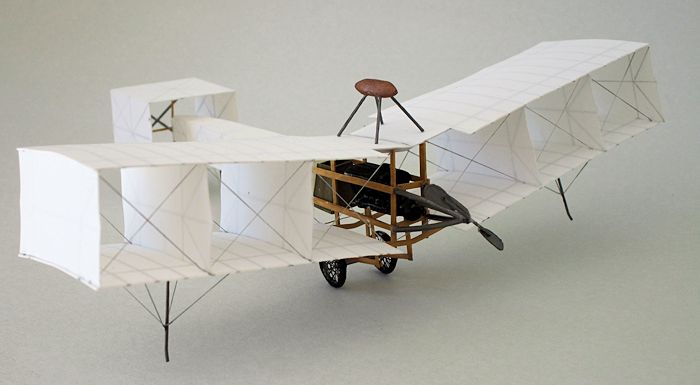 A small, dapper
man, he started a fashion for his high collars, and also for his wide brim
panama hat which he always wore. He even had a special high table and chairs
made, so that he could dine about 12 feet above the ground and get used to being
aloft. One cannot help but wonder if his very small stature, he was no more than
5 feet tall, had something to do with his desire to see the world from above.
Everyone said that he had perfect manners.
A small, dapper
man, he started a fashion for his high collars, and also for his wide brim
panama hat which he always wore. He even had a special high table and chairs
made, so that he could dine about 12 feet above the ground and get used to being
aloft. One cannot help but wonder if his very small stature, he was no more than
5 feet tall, had something to do with his desire to see the world from above.
Everyone said that he had perfect manners.
This, his first heavier than air machine, the 14bis took to the air under its own power, as opposed to the Wright Brothers machine which used launch rails, in October 1906. And was the first heavier-than-air aircraft flight to be certified by the Aéro Club de France and the Fédération Aéronautique Internationale (FAI). It was also the first flight to be witnessed by large crowds, as the Wright Brothers had flown with just a couple of people watching. In France the few who had heard of the Wright Brothers' flight treated it with some suspicion, if not disbelief. As far as Europe was concerned Santos-Dumont was king.
| CONSTRUCTION |
There are plenty of scale drawings on various of the websites below. And the dimensions are also widely available, in order to set the scale.
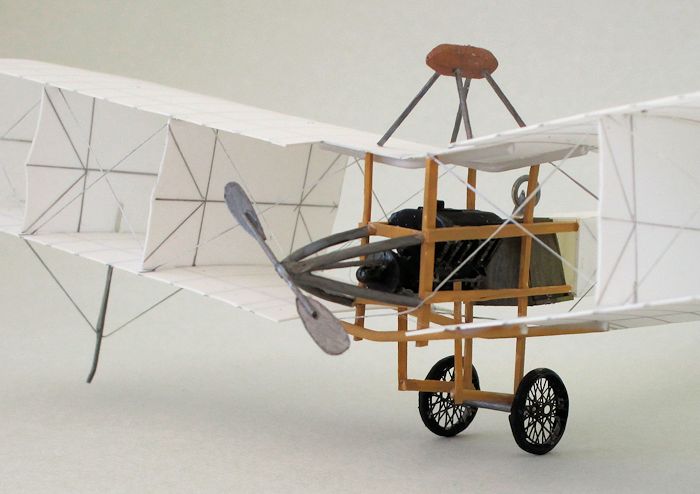 How often have you read that work began on the cockpit? I cannot provide any
surprise on that score, except to say that the cockpit was in fact an unused
balloon basket, which I assume Santos-Dumont had hanging around his workshop,
and decided to make do with. It is easily made from card, but it should be noted
that it is standing room only, and that the sides slope inwards towards the top,
like a cross section of a pyramid. The wicker work is implied by some judicious
dry brushing of various shades of brown. If you want to get fancy, you could try
scoring the sides to imitate the wickerwork. Or even weaving a tiny basket of
your own. Once done set aside.
How often have you read that work began on the cockpit? I cannot provide any
surprise on that score, except to say that the cockpit was in fact an unused
balloon basket, which I assume Santos-Dumont had hanging around his workshop,
and decided to make do with. It is easily made from card, but it should be noted
that it is standing room only, and that the sides slope inwards towards the top,
like a cross section of a pyramid. The wicker work is implied by some judicious
dry brushing of various shades of brown. If you want to get fancy, you could try
scoring the sides to imitate the wickerwork. Or even weaving a tiny basket of
your own. Once done set aside.
This is one of those early aircraft which seems to be flying backwards. Aviation was at the suck-it-and-see phase and all sorts of aerodynamic problems had yet to be sorted out. Still, he undoubtedly got a number of things right. The boxy cell of the canard planes is mounted on a universal joint, and so emulates modern all-flying surfaces. The struts for the main wings are also faired over in cells, which would have acted like wing fences in smoothing the airflow. That dihedral looks unnecessarily sharp, but the beast left the ground, and so who are we to criticise?
Since photos show that the framework was visible through the linen, I first pencilled in rib lines with a dark pencil, before spraying all surfaces with matt white. The wing ribs got slightly heavier treatment from a black biro.
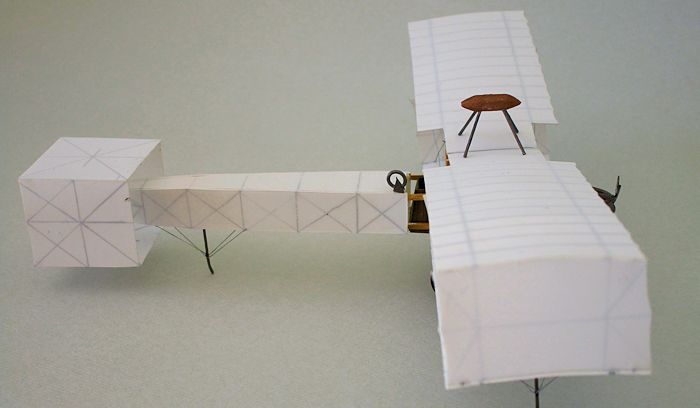 The forward part
of the fuselage can be put together from four strips of card, while noting that
they taper at the front end. The rear part of the fuselage behind the cockpit,
is a simple cat's cradle, made from square section off cuts from the edge of 20
thou card. Note that the uprights will be supporting the wings and also the
undercarriage, so take some time to get the lengths right and make sure it is
all in alignment. Alignment is always the thing that scratch builders have most
problems with.
The forward part
of the fuselage can be put together from four strips of card, while noting that
they taper at the front end. The rear part of the fuselage behind the cockpit,
is a simple cat's cradle, made from square section off cuts from the edge of 20
thou card. Note that the uprights will be supporting the wings and also the
undercarriage, so take some time to get the lengths right and make sure it is
all in alignment. Alignment is always the thing that scratch builders have most
problems with.
It would be best to try to fit your V-8 engine in before finishing the fuselage around it. You can safely guess how I know this. Large chunks of my hair are still lying on the floor of my study. I found an engine in my spares box, and while I cannot absolutely guarantee that it is the 50hp Antoinette of the original, it looks the part.
The wings are simple rectangles of 10 thou card, scored for ribs and bent around a hobby knife handle to get the right camber. Assembling the struts is made very easy by the fact that they were faired in, and so resemble a set of boxes.
There is always a crunch time with any model, when a part of it which you had
foreseen as being tricky suddenly arrives. It usually helps that you have been
brooding on it while making the easy stages. With this model, I could see that
rigging inside the box cells was going to prove difficult. I envisaged poking
each wire inside the box with tweezers and then patiently waiting until each one
set. But fate took a hand when one of them gently lifted free of its glue at the
forward end. I slipped some elastic thread, pre-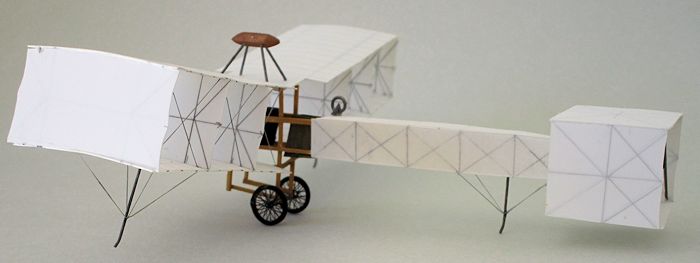 coloured with a silver gel pen,
into the gap, super-glued it in place and snipped off the excess. Then it was a
case of gently inserting a scalpel blade under the leading or trailing edge of
each box section and lifting it free of the wings, then repeating the trick with
the thread. In no time at all, the whole thing was rigged, and I felt very smug.
coloured with a silver gel pen,
into the gap, super-glued it in place and snipped off the excess. Then it was a
case of gently inserting a scalpel blade under the leading or trailing edge of
each box section and lifting it free of the wings, then repeating the trick with
the thread. In no time at all, the whole thing was rigged, and I felt very smug.
A control wheel of solder was set on a quadrant of scrap. A fuel tank was sanded from sprue, painted copper, and mounted on four rods. Wire wheels came courtesy of Eduard's excellent WWI etched sets, with tires made of solder. The skids were bent rod, held in place by more rigging. Note that the whole beast has a distinctly nose down attitude.
Finally, the propeller, which for once did not come from the spares box. It is a simple affair of two flat blades mounted on a central rod at a twist. Very inefficient it was too, giving only about 20 per cent of the power which a properly shaped propeller would. But as I said earlier, these were early days when every flight was a way forward to better design.
| CONCLUSIONS |
It is a pretty little thing, even though it seems to be going backwards. And what you are looking at is the European equivalent of the Wright brothers flyer. One of my grandfathers was alive when it first went aloft. He later became an aviator in WWI. And he lived to see the first landings on the moon only 60 years after Santos-Dumont took off. He lived through an extraordinary era of aviation, one in which the rate of progress was unparalleled, before or since.
| REFERENCES |
http://www.britannica.com/topic/Santos-Dumont-No-14-bis
http://www.airliners.net/photo/Santos-Dumont-14-BIS/1429679/
http://individual.utoronto.ca/firstflight/
https://it.wikipedia.org/wiki/Santos-Dumont_14-bis
Copyright ModelingMadness.com November 2015 If you would like your product reviewed fairly and fairly quickly, please
contact the editor or see other details in the
Note to
Contributors.